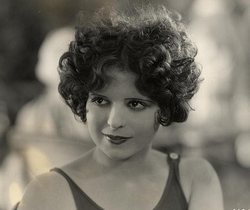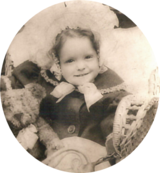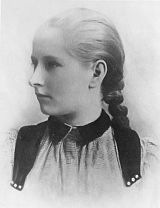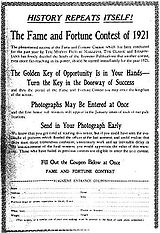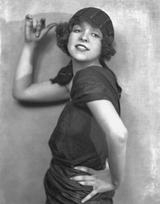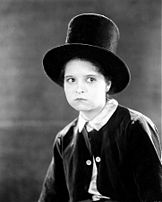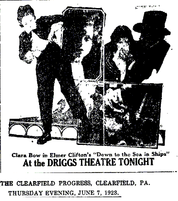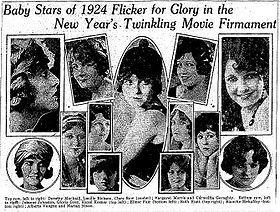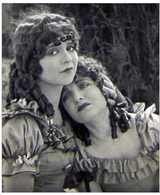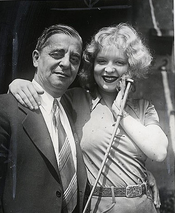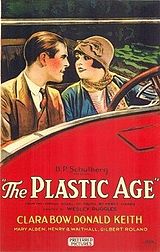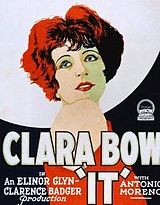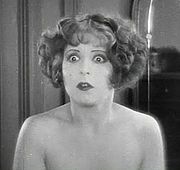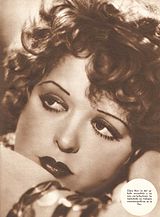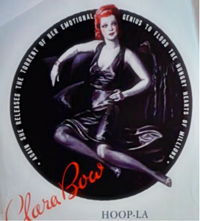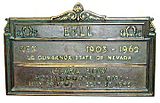- Clara Bow
-
Clara Bow
in Rough House Rosie (1927)Born Clara Gordon Bow
July 29, 1905
Brooklyn, New York, U.S.Died September 27, 1965 (aged 60)
West Los Angeles, California, U.S.Occupation Actress Years active 1921–1933 Spouse Rex Bell (m. 1931–1962) (his death) Children Tony Beldam (1934-2011)
George Beldam, Jr. (b. 1938)Clara Gordon Bow (July 29, 1905 – September 27, 1965) was an American actress who rose to stardom in the silent film era of the 1920s. It was her appearance as a spunky shopgirl in the film It that brought her global fame and the nickname "The It Girl." Bow came to personify the roaring twenties[1] and is described as its leading sex symbol.[2] She appeared in 46 silent films and 11 talkies, including hits such as Mantrap (1926), It (1927) and Wings (1927). She was named first box-office draw in 1928 and 1929 and second box-office draw in 1927 and 1930.[3][4] Her presence in a motion picture was said to have ensured investors, by odds of almost 2-to-1, a "safe return".[5] In January 1929, at the apex of her stardom, she received more than 45,000 fan letters.[6] After marrying actor Rex Bell in 1931, Bow ended her career in 1933 with the film with Hoop-La, becoming a rancher in Nevada.
Contents
Early life
Clara Bow was born in 1905 [7]in a slum tenement in Prospect Heights, Brooklyn, New York, where she was also raised.[8] Bow was the third child; the first two, also daughters, born in 1903 and 1904, died in infancy.[9] Her mother, Sarah Bow (1880–1923), was told by a doctor not to become pregnant again for fear the next baby might die as well. Despite the her doctor's warning, Sarah Bow became pregnant with Clara in the fall of 1904. In addition to the risky pregnancy, a heat wave besieged New York in July 1905 and temperatures peaked around 100 °F;[10] the infant mortality rate rose to 80%.[9] "I don't suppose two people ever looked death in the face more clearly than my mother and I the morning I was born. We were both given up, but somehow we struggled back to life".[11]
At sixteen, Sarah fell from a second-story window and suffered a severe head injury. She was later diagnosed with "psychosis due to epilepsy",[12] a condition apart from the seizures that is known to cause disordered thinking, delusional ideation, paranoia, and aggressive behavior.[13]
From her earliest years, Bow learned how to care for her mother during the seizures as well as how to deal with the psychotic and hostile episodes. She said her mother could be "mean" to her, but "didn't mean to ... she couldn't help it".[11] Still, Bow felt deprived of her childhood; "As a kid I took care of my mother, she didn't take care of me".[14] Sarah worsened gradually, and when she realized her daughter was set for a movie career, Bow's mother told her she "would be much better off dead". One night in February 1922, Bow awoke to a butcher knife held against her throat by her mother. Bow was able to fend off the attack and locked her mother up. In the morning, Sarah had no recollection of the episode and was later committed to a charity hospital.[11]
Bow said that her father, Robert (1874–1959), "had a quick, keen mind ... all the natural qualifications to make something of himself, but didn't".[11] Robert seldom managed to hold on to a job and the family income varied drastically as a result. Between 1905 and 1923, the family lived at 14 different addresses.[15] Robert was often absent, leaving his family without means to survive.[16] "I do not think my mother ever loved my father. He knew it. And it made him very unhappy, for he worshiped her, always".[11]
It was snowing. My mother and I were cold and hungry. We had been cold and hungry for days. We lay in each others arms and cried and tried to keep warm. It grew worse and worse. So that night my mother – but I can't tell you about it. Only when I remember it, it seems to me I can't live[17]
Sarah Bow died on January 5, 1923. When relatives gathered for the funeral, Bow accused them of not being supportive in the past. Reportedly, her anger led her to attempt jumping into her mother's open grave.[11]
As Bow grew up she felt shy among other girls, who teased her for her worn-out clothes and "carrot-top" hair. From first grade, Bow preferred the company of boys her age, stating, "I could lick any boy my size. My right arm was quite famous. My right arm was developed from pitching so much ... Once I hopped a ride on behind a big fire engine. I got a lot of credit from the gang for that".[11] Bow's athletic ability led her to becoming a track champion in high-school. Of her proposed arm strength, Louella Parsons noted, "... curiously enough, she has muscles on her arms that stand out like whip-cord".[18]
Motion pictures
In the early 1920s, roughly 50 million Americans--half the population at that time--attended the movies every week.[19] Bow discovered that as she grew into womanhood, her stature as a "boy" in her old gang would be "impossible". As well, she didn't have any girlfriends, school was a "heartache" and home "miserable". On the silver screen, however, she found consolation; "For the first time in my life I knew there was beauty in the world. For the first time I saw distant lands, serene, lovely homes, romance, nobility, glamor". And further; "I always had a queer feeling about actors and actresses on the screen ... I knew I would have done it differently. I couldn't analyze it, but I could always feel it".[11] "I'd go home and be a one girl circus, taking the parts of everyone I'd seen, living them before the glass."[20] At sixteen Bow "knew" she wanted to be a motion pictures actress, even if she was a "square, awkward, funny-faced kid".[11]
The New York starlet (1921-1923)
The Fame and Fortune contest
Against her mother's wishes but with her father's support, Bow competed in Brewster publications' magazine's annual nationwide acting contest, Fame and Fortune in 1921. In previous years, several of the contest's winners had found work in movies after winning.[21] In the contest's final screen test Bow was up against an already scene-experienced woman who did "a beautiful piece of acting". A set member later stated that when Bow did the scene she actually became her character and "lived it".[22] In the January issues 1922 of Motion Picture Classics the contest jury, Howard Chandler Christy, Neysa Mcmein, and Harrison Fisher, concluded:
She is very young, only 16. But she is full of confidence, determination and ambition. She is endowed with a mentality far beyond her years. She has a genuine spark of divine fire. The five different screen tests she had, showed this very plainly, her emotional range of expression provoking a fine enthusiasm from every contest judge who saw the tests. She screens perfectly. Her personal appearance is almost enough to carry her to success without the aid of the brains she indubitably possesses.
Beyond the Rainbow (1922)
Bow won an evening gown and a silver trophy and the publisher committed to help her "gain a role in films". But nothing happened. Bow's father told her to "haunt" Brewster's office (located in Brooklyn) until they came up with something. "To get rid of me, or maybe they really meant to (give me) all the time and were just busy", Bow was introduced to director Christy Cabanne who cast her in Beyond the Rainbow, produced late 1921 in New York City and released February 19, 1922.[23] Bow did five scenes, impressed Cabanne with true theatrical tears,[11] but was eventually cut from the print. Bow wasn't told, but found out when she saw the movie at a theater in Brooklyn. "I was sick to my stomach", she recalled and thought her mother was right about the movie business. Bow, who dropped out of school after she was notified about winning the contest, possibly in October 1921, got an ordinary office job.[24] However, movie ads and newspaper editorial comments from 1922–1923 suggest that Bow was not cut from Beyond the Rainbow. Her name is on the cast list among the other stars, usually tagged "Brewster magazine beauty contest winner" and sometimes even with a picture.[25]
Down to the Sea in Ships (1923)
Encouraged by her father, Bow started to run around studio agencies asking for parts. "But there was always something. I was too young, or too little, or too fat. Usually I was too fat."[11] Eventually director Elmer Clifton needed a tomboy for his movie Down to the Sea in Ships, saw Bow in Motion Picture Classic magazine and sent for her. In an attempt to overcome her youthful looks, Bow put her hair up and arrived in a dress she 'sneaked' from her mother. Clifton said she was too old, but broke into laughter as the stammering Bow made him believe she was the girl in the magazine. Clifton decided to bring Bow with him and offered her $50 a week, but added he couldn't say whether or not she would "fit the part".[26]
Down to the Sea in Ships was shot on location in New Bedford, Massachusetts, produced by Independent 'The Whaling Film Corporation', and documented the life, love and work in the whale-hunter community. The production relied on a few less known actors and local talents. It premiered at 'Olympia', New Bedford, on September 25, and went on general distribution on March 4, 1923.
Bow was billed 10th, but shined through and critics sang her praise:
- "Miss Bow will undoubtedly gain fame as a screen comedienne".[27]
- "She scored a tremendous hit in Down to the Sea in Ships..(and)..has reached the front rank of motion picture principal players".[28]
- "With her beauty, her brains, her personality and her genuine acting ability it should not be many moons before she enjoys stardom in the fullest sense of the word. You must see 'Down to the Sea in Ships'".[29]
- "In movie parlance, she 'stole' the picture ... ".[30]
WAMPAS Baby Star (1924)
Bow found herself walking time after time by a Broadway movie theater, staring at her name in shimmering electric light above the entrance. "I can never tell you what happiness I felt, life had been so terrible hard and it seemed to me that now all my troubles were to be in the past".[26] By mid December 1923, primarily due to her merits in Down to the Sea in Ships, Bow was chosen the most successful of the 1924 WAMPAS Baby Stars.[32]
Grit (1924)
Three months before Down to the Sea in Ships was released, Bow danced half nude, on a table, unaccredited in Enemies of Women (1923).[33] In spring she got a part in The Daring Years (1923), were she befriended actress Mary Carr, who taught her how to use make-up.[34]
In the summer, she got a "tomboy" part in Grit, a story, which dealt with juvenile crime and was written by F. Scott Fitzgerald. Bow met her first boyfriend, cameraman Arthur Jacobson, and she got to know director Frank Tuttle, with whom she worked in five later productions. Tuttle remembered:
Her emotions were close to the surface. She could cry on demand, opening the floodgate of tears almost as soon as I asked her to weep. She was dynamite, full of nervous energy and vitality and pitifully eager to please everyone".[26]
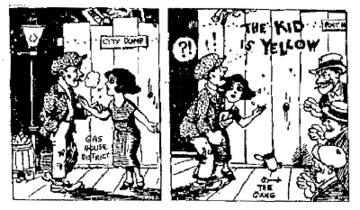 Cartooned: Bow as "Orchid McGonigle" in Grit, having a hard time keeping her boy-friend "Kid Hart" (Glenn Hunter) on track.[35]
Cartooned: Bow as "Orchid McGonigle" in Grit, having a hard time keeping her boy-friend "Kid Hart" (Glenn Hunter) on track.[35]
Grit was released on January 7, 1924. Variety reviewed;
- "... Clara Bow lingers in the eye, long after the picture has gone."[36]
While shooting Grit at Pyramid Studios, in Astoria, New York, Bow was approached by Jack Bachman of independent Hollywood studio Preferred Pictures. He wanted to contract her for a three months trial, fare paid and $50 a week. "It can't do any harm",[11] he tried. "Why can't I stay in New York and make movies?", Bow asked her father, but he told her not to worry.[37]
On July 21, 1923 she befriended Louella Parsons, who interviewed her for The New York Morning Telegraph. In 1931 when Bow came under tabloid scrutiny, Parsons defended her and stuck to her first opinion on Bow:[38]
She is as refreshingly unaffected as if she had never faced a means to pretend. She hasn't any secrets from the world, she trusts everyone ... she is almost too good to be true ... (I) only wish some reformer who believes the screen contaminates all who associate with it could meet this child. Still on second thought it might not be safe: Clara uses a dangerous pair of eyes.
The interview also revealed that Bow already was cast in Maytime and in great favor of Chinese cuisine.[39]
Hollywood (1923-1933)
Preferred Pictures (1923-1925)
July 22, 1923, Bow left New York, her father and her boyfriend behind.[40] As chaperon for the journey and stay in Hollywood, the studio appointed writer/agent Maxine Alton, who Bow later branded a liar.[11] In late July Bow entered studio chief B. P. Schulberg's office wearing a simple high-school uniform in which she "had won several gold medals on the cinder track".[41] She was tested and a press-release from early August says Bow had become a member of Preferred Picture's "permanent stock".[42] She and Alton rented an apartment at The Hillview near Hollywood Boulevard.[40] Preferred Pictures was run by Schulberg who started as a publicity manager at Famous Players-Lasky, but in the aftermath of the power struggle around the formation of United Artists ended up on the losing side and lost his job. In 1919, at age 27, he founded 'Preferred'.[43]
Maytime (1923)
Bow's first Hollywood picture was an adaptation of the popular operetta Maytime, in which she essayed "Alice Tremaine". Before Maytime was finished, Schulberg announced that Bow was given the lead in the studio's biggest seasonal assessment, Poisoned Paradise,[41] but first she was lent to First National Pictures to co-star in the adaptation of Gertrude Atherton's 1923 bestseller Black Oxen, shot in October, and to co-star with Colleen Moore in Painted People, shot in November.[44]
Black Oxen (1923)
 Bow as "Janet", the "horrid" flapper in Black Oxen (1923), holding Flaming Youth to her chest; with Kate Lester and Tom Ricketts
Bow as "Janet", the "horrid" flapper in Black Oxen (1923), holding Flaming Youth to her chest; with Kate Lester and Tom Ricketts
Director Frank Lloyd was casting for the part of high society flapper Janet Oglethorpe, and more than fifty women, most with previous screen experience, auditioned.[40] Bow reminisced; "He had not found exactly what he wanted and finally somebody suggested me to him. When I came into his office a big smile came over his face and he looked just tickled to death".[11] Lloyd told the press; "Bow is the personification of the ideal aristocratic flapper, mischievous, pretty, aggressive, quick-tempered and deeply sentimental".[45] It was released on January 4, 1924.
- New York Times: "The flapper, impersonated by a young actress, Clara Bow, had five speaking titles, and every one of them was so entirely in accord with the character and the mood of the scene that it drew a laugh from what, in film circles, is termed a "hard-boiled" audience"[46]
- Los Angeles Times: "Clara Bow, the prize vulgarian of the lot...was amusing and spirited...but didn't belong in the picture".[47]
- Variety: "...the horrid little flapper is adorably played...".[48]
Painted People controversy
Colleen Moore made her flapper debut in a successful adaptation of the daring novel Flaming Youth, released November 12, 1923, six weeks before Black Oxen. Both films were produced by First National Pictures, and while Black Oxen was still being edited and Flaming Youth not yet released, Bow was requested to co-star Moore as her kid sister in Painted People (AKA The Swamp Angel).[49]
Moore essayed the baseball-playing tomboy and Bow, according to Moore, said "I don't like my part, I wanna play yours".[50] Moore, a well-established star earning $1200 a week — Bow got $200 — took offense and blocked the director from doing a close-up on Bow. Moore was married to a studio executive and Bow's protests fell short. "I'll get that bitch", she told her boyfriend Jacobson, who had arrived from New York. Bow had sinus problems and decided to have them attended to immediately. A bandaged Bow left the studio with no options but to recast her part.[51]
 ... pastiched by Frank Morgan & Jean Harlow in Bow's ex-fiancee Victor Fleming's screwball comedy Bombshell (1933)
... pastiched by Frank Morgan & Jean Harlow in Bow's ex-fiancee Victor Fleming's screwball comedy Bombshell (1933)
1924
The Perfect Flapper
During 1924 Bow's "horrid" flapper raced against Moore's "whimsical".[52] In May Moore renewed her efforts in The Perfect Flapper, produced by her husband, but despite good reviews she suddenly withdrew. "No more flappers ... they have served their purpose ... people are tired of soda-pop love affairs", she told the Los Angeles Times,[52] that commented a month earlier, "Clara Bow is the one outstanding type. She has almost immediately been elected for all the recent flapper parts"[53] In November 1933, Bow described the Hollywood years as a French Revolution picture, where "women are hollering and waving pitchforks twice as violently as any of the guys ... the only ladies in sight are the ones getting their heads cut off".[54]
"If that's what my baby wants, that's what my baby does"[55]
By New Year 1924, Bow defied the possessive Maxine Alton and brought her father to Hollywood. Bow remembered their reunion; "I didn't care a rap, for (Maxine Alton), or B. P. Schulberg, or my motion picture career, or Clara Bow, I just threw myself into his arms and kissed and kissed him, and we both cried like a couple of fool kids. Oh, it was wonderful".[11] Bow felt Alton had misused her trust; "She wanted to keep a hold on me so she made me think I wasn't getting over and that nothing but her clever management kept me going".[11] Bow and her father moved in at 1714 North Kingsley Drive in Beverly Hills, together with Jacobson, whom by then, also worked for Preferred. When Schulberg learned of this arrangement, he fired Jacobson for potentially getting "his big star" into a scandal. When Bow found out, "She tore up her contract and threw it in his face and told him he couldn't run her private life". Jacobson concluded, "[Clara] was the sweetest girl in the world, but you didn't cross her and you didn't do her wrong".[56] On September 7, 1924, The Los Angeles Times, in a significant article "A dangerous little devil is Clara, impish, appealing, but oh, how she can act!", her father is titled "business manager" and Jacobson referred to as her brother.[57]
Bow appeared in eight releases in 1924.
- In Poisoned Paradise, released on February 29, 1924, Bow got her first lead. "... the clever little newcomer whose work wins fresh recommendations with every new picture in which she appears".[58] In a scene, described as "original", Bow adds "devices", to "the modern flapper"; she fights a villain, using her fists, and significantly, does not "shrink back in fear".[59]
- In Daughters of Pleasure, also released on February 29, 1924, Bow and Marie Prevost, "flapped unhampered as flappers De luxe ... I wish somebody could star Clara Bow. I'm sure her 'infinite variety' would keep her from wearying us no matter how many scenes she was in".[60]
Wine (1924)
As an out-loan to Universal-Jewel, Bow top-starred, for the first time, in the prohibition, bootleg drama/comedy Wine, released on August 20, 1924. The picture exposes the widespread liquor traffic in the upper-classes, and Bow portrays an innocent girl who develops into a wild "redhot mama".
- "If not taken as information, it is cracking good entertainment", Carl Sandburg reviewed September 29.[61]
- "Don't miss Wine. It's a thoroughly refreshing draught ... there are only about five actresses who give me a real thrill on the screen — and Clara is nearly five of them".[62]
Alma Whitaker of The Los Angeles Times observed on September 7, 1924:
She radiates sex appeal tempered with an impish sense of humor ... She hennas her blond hair so that it will photograph dark in the pictures ... Her social decorum is of that natural, good-natured, pleasantly informal kind ... She can act on or off the screen — takes a joyous delight in accepting a challenge to vamp any selected male — the more unpromising specimen the better. When the hapless victim is scared into speechlessness she gurgles with naughty delight and tries another.Bow remembered: "All this time I was "running wild", I guess, in the sense of trying to have a good time ... maybe this was a good thing, because I suppose a lot of that excitement, that joy of life, got onto the screen".[11]
1925
1925 Bow appeared in fourteen productions: six for her contract owner, Preferred Pictures, and eight as an "out-loan".
- "Clara Bow ... shows alarming symptoms of becoming the sensation of the year ... ", Motion Picture Classic Magazine wrote in June, and featured her on the cover.[63]
"I'm almost never satisfied with myself or my work or anything...by the time I'm ready to be a great star I'll have been on the screen such a long time that everybody will be tired of seeing me...(Tears filled her big round eyes and threatened to fall)".[64]"I worked in two and even three pictures at once. I played all sorts of parts in all sorts of pictures ... It was very hard at the time and I used to be worn out and cry myself to sleep from sheer fatigue after eighteen hours a day on different sets, but now (late 1927) I am glad of it"[11]Preferred Pictures rented Bow to producers "for sums ranging from $1500 to $2000 a week".[65] The studio like any other independent studio or theater at that time, was under attack from "The Big Three", MPAA, who had formed a trust to block out Independents and enforce the monopolistic studio system.[66] On October 21, 1925, Schulberg filled Preferred Pictures for bankruptcy, with debts at $820,774 and assets $1,420.[67] Three days later, it was announced that Schulberg would join with Adolph Zukor and became associate producer of Paramount Pictures, bringing his organization, including Bow.[68]
Adolph Zukor, Paramount Picture CEO in his memoirs: "All the skill of directors and all the booming of press-agent drums will not make a star. Only the audiences can do it. We study audience reactions with great care".[69] Adela Rogers St. Johns had a different take, in 1950 she wrote: "If ever a star was made by public demand, it was Clara Bow".[70] And Louise Brooks from 1980: "(Bow) became a star without nobody's help ... ".[71]
The Plastic Age (1925)
The Plastic Age was Bow's final effort for Preferred Pictures and her biggest hit so far. Bow starred as the good-bad college-girl, Cynthia Day against Donald Keith. It was shot on location, at Pomona College, in the summer of 1925, and released on December 15, but due to block booking, not shown in New York until July 21, 1926.
- Photoplay was displeased: "The college atmosphere is implausible and Clara Bow is not our idea of a college girl".[72]
- Theater owners however, were happy: "The picture is the biggest sensation we ever had in our theater ... It is 100 per cent at the box-office".[73]
- Some critics felt Bow conquered new territory: "(Bow) presents a whimsical touch to her work that adds greater laurels to her fast ascending star of screen popularity".[74]
- Time singled out Bow: "Only the amusing and facile acting of Clara Bow rescues the picture from the limbo of the impossible".[75]
Bow began to date her co-star Gilbert Roland, who became her first fiancee. In June 1925, Bow was credited for being the first to wear hand-painted legs in public and was reported to have many followers at the Californian beaches.[76]
Paramount Pictures (1925-1931)
The free-wheeling actress
"Rehearsals sap my pep", Bow explained in November, 1929[77] and from the beginning of her career she relied on immediate direction: "Tell me what I have to do and I'll do it".[78] Bow was keen on poetry and music but according to Rogers St. Johns, her attention-span didn't allow her to appreciate novels.[79] Bow's focal point was the scene and her creativity made directors call in extra cameras to cover her spontaneous actions, rather than holding her down.[78]
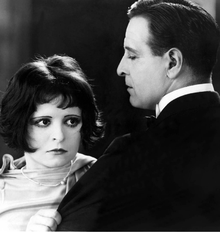 Bow as "Kittens" in Dancing Mothers (1926), moments from realizing that her mother is her rival. Conway Tearle as "Jerry" caught in between.
Bow as "Kittens" in Dancing Mothers (1926), moments from realizing that her mother is her rival. Conway Tearle as "Jerry" caught in between.
- Years after Bow left Hollywood, director Victor Fleming compared Bow to a Stradivarius violin: "Touch her and she responded with genius".[80]
- Director William Wellman was less poetic: "Movie stardom isn't acting ability — it's personality and temperament ... I once directed Clara Bow ("Wings"). She was mad and crazy but WHAT a personality!".[81]
- In 1981 Budd Schulberg described Bow as "a easy winner of the dumbbell award" who "couldn't act" and compared her to a puppy who his father B.P. Schulberg, "trained to become Lassie".[82]
1926
In 1926 Bow appeared in eight releases: five for Paramount, and three as an "out-loan", shot in 1925.
Dancing Mothers (1926)
In late 1925, Bow returns to New York to co-star in the Ibsenesque[83] drama Dancing Mothers, as the good/bad "flapperish" upper-class daughter "Kittens". Alice Joyce starred as her "dancing mother" with Conway Tearle as "bad-boy" Naughton. The picture was released on March 1, 1926.[84]
- "Clara Bow known as the screen's perfect flapper, does her stuff as the child, and does it well".[85]
- "... her remarkable performance in Dancing Mothers ... ".[86]
- Louise Brooks remembered: "She was absolutely sensational in the United States ... in Dancing Mothers ... she just swept the country ... I know I saw her ... and I thought ... wonderful".[71]
On April 12, 1926, Bow signs her first contract with Paramount: "...to retain your services as an actress for the period of six months from June 6th, 1926 to December 6th, 1926, at a salary of $750.00 per week...".[87]
Mantrap (1926)
In Victor Fleming's comedy-triangle Mantrap Bow, as Alverna the manicurist, cures lonely hearts Joe Easter (Ernest Torrence), of the great northern, as well as pill-popping New York divorcee attorney runaway Ralph Prescott (Percy Marmont). Bow commented: "(Alverna)...was bad in the book, but - darn it! - of course, they couldn't make her that way in the picture. So I played her as a flirt".[88]
The film was released on July 24, 1926.[89]
- Variety: "Clara Bow just walks away with the picture from the moment she walks into camera range".[90]
- Photoplay: "When she is on the screen nothing else matters. When she is off, the same is true".[91]
- Carl Sandburg: "The smartest and swiftest work as yet seen from Miss Clara Bow".[92]
- The Reel Journal: "Clara Bow is taking the place of Gloria Swanson...(and)...filling a long need for a popular taste movie actress".[93]
On August 16, 1926, Bow's agreement with Paramount was renewed into a five year deal: "Her salary will start at $1700 a week and advance yearly to $4000 a week for the last year".[94]
Notably Bow added that she intended to leave the motion picture business at the expiration of the contract, i.e. 1931.[95]
1927
It (1927)
In the Cinderella story It, the poor shop-girl Betty Lou Spence (Bow) conquers the heart of her employer Cyrus Waltham (Antonio Moreno). The personal quality It, provides the magic to make it happen. The film gave Bow her nickname "The It Girl." It was first shown in New York on February 5, 1927.
- New York Times: "(Bow)...is vivacious and, as Betty Lou, saucy, which perhaps is one of the ingredients of 'It'".[96]
- The Film Daily: "Clara Bow gets a real chance and carries it off with honors...(and)...she is really the whole show".[97]
- Carl Sandburg: "'It' is smart, funny and real. It makes a full-sized star of Clara Bow".[98]
- Variety: "You can't get away from this Clara Bow girl. She certainly has that certain 'It'...and she just runs away with the film".[99]
- Dorothy Parker: "It, hell: She had Those".[100]
Wings (1927)
In 1927, Bow starred in Wings, a war picture largely rewritten to accommodate her, as she was Paramount's biggest star. The film went on to win the first Academy Award for Best Picture.
I'm a big freak, because I'm myself!
A famous scenario writer, who had done a number of pictures with Bow said:
"Clara is the total nonconformist. What she wants she gets, if she can. What she desires to do she does. She has a big heart, a remarkable brain, and the most utter contempt for the world in general. Time doesn't exist for her, except that she thinks it will stop tomorrow. She has real courage, because she lives boldly. Who are we, after all, to say she is wrong?"[79]
Bow's bohemian lifestyle and "dreadful" manners were considered reminders of the Hollywood Elite's uneasy position in high society.[101]
Bow fumed: "They yell at me to be dignified. But what are the dignified people like? The people who are held up as examples of me? They are snobs. Frightful snobs ... I'm a curiosity in Hollywood. I'm a big freak, because I'm myself!"[102]
MGM executive Paul Bern said Bow was "the greatest emotional actress on the screen", "sentimental, simple, childish and sweet", and considered her "hard-boiled attitude" a "defense mechanism".[103]
1929
Talkies
With "talkies" The Wild Party, Dangerous Curves, and The Saturday Night Kid, Bow kept her position as the top box-office draw and queen of Hollywood.[104]
The quality of Bow's voice, her Brooklyn accent, was not an issue to Bow, her fans or Paramount.[105] However, Bow, like Charlie Chaplin, Louise Brooks and most other silent film-stars didn't embrace the novelty: "I hate talkies", she said, "they're stiff and limiting. You lose a lot of your cuteness, because there's no chance for action, and action is the most important thing to me".[106] The inventor of the motion picture camera, Thomas Edison himself, was so annoyed by the stiffness of the early "talkies" that he refused to see them and returned to his favorite "silents" with Bow and Mary Pickford.[107] A visibly nervous Bow had to do a number of retakes in The Wild Party because her eyes kept wandering up to the microphone overhead. "I can't buck progress", Bow resigned, "I have to do the best I can".[106]
In October 1929 Bow describes her nerves as "all shot", that she has reached "the breaking point" and Photoplay reports of "rows of bottles of sedatives" by her bed.[108]
1930
According to census 1930, Bow lives at Bedford Drive 512, together with her secretary and hair-dresser, Daisy DeBoe, in a house valued $25,000 with neighbors titled "Horse-keeper", "Physician", "Builder". Bow states she is 23 years old, i.e. born 1906, contradicting Census of 1910 and 1920.[109]
"Now they're having me sing. I sort of half-sing, half-talk, with hips-and-eye stuff. You know what I mean — like Maurice Chevalier. I used to sing at home and people would say, 'Pipe down! You're terrible!' But the studio thinks my voice is great".[106]
With Paramount on Parade, "True to the Navy", "Love Among the Millionaires" and "Her Wedding Night", she was second at the box-office to her chum, Joan Crawford in 1930.[4]
1931-1933
With No Limit and Kick In, Bow held the position as fifth at box-office in 1931. But the pressures of fame, public scandals, overwork and a damaging court trial with her secretary, Daisy DeBoe, took their toll on Bow's fragile emotional health. As she slipped closer to a major breakdown, her manager B.P. Schulberg began referring to her as "Crisis-a-day-Clara".[110] In April Bow was brought to a sanatorium, and at her request, Paramount released her from her final undertaking: City Streets.
B.P. Schulberg tried to replace Bow with his girlfriend Sylvia Sidney, but Paramount lost its position as the biggest studio to MGM and B.P. Schulberg got fired. David Selznick explained:
"(when)..Bow was at her height in pictures we could make a story with her in it and gross a million and a half, where another actress would gross half a million in the same picture and with the same cast."[111]Bow left Hollywood for Rex Bells ranch in Nevada, her "desert paradise", in June[112] and got married to him in then small town Las Vegas in December[113] In an interview of December 17 Bow detailed her way back to health: Sleep, exercise and food, and the day after she returned to her Hollywood home ready for work.[114]
Soon every studio in Hollywood (except for Paramount)[115] and even overseas.[116] wanted her services.
- Mary Pickford stated that Bow "was a very great actress" and wanted her to play her sister in Secrets.[117].
- Howard Hughes offered her a three-picture deal.[118]
- MGM wanted Bow to star in Red Headed Woman and Bow agreed to the script, but eventually rejected the offer since Thalberg required her to sign a long-term contract.[119]
On April 28, 1932, Bow signed a two-picture deal with Fox Film Corporation; Call Her Savage (1932) and Hoop-La (1933). Both successful, Variety favored the latter:
- "A more mature performance...she looks and photographs extremely well".[120]
Bow commented on her revealing costume in Hoop-La: "Rex accused me of enjoying showing myself off. Then I got a little sore. He knew darn well I was doing it because we could use a little money these days. Who can't?".[121] Bow concluded her career:
"My life in Hollywood contained plenty of uproar. I'm sorry for a lot of it but not awfully sorry. I never did anything to hurt anyone else. I made a place for myself on the screen and you can't do that by being Mrs. Alcott's idea of a Little Women".[122]Later life
Bow and cowboy actor Rex Bell, later a Lieutenant governor of Nevada, had two sons, Tony Beldam (born 1934, changed name to Rex Anthony Bell, Jr., died July 2011) and George Beldam, Jr. (born 1938). Bow retired from acting in 1933. In September 1937, she and Bell opened The 'It' Cafe on Vine Street near Hollywood Blvd. in Los Angeles. It was closed shortly thereafter.[123] Her last public exposure, albeit fleeting, was a guest appearance on the radio show Truth or Consequences in March 1948; Bow provided the voice of "Mrs. Hush".
Health issues
In 1944, while Bell was running for the U.S. House of Representatives, Bow tried to commit suicide.[124]
A note was found in which Bow stated she preferred death to a public life.[123]
In 1949 she checked into The Institute of Living to be treated for her chronic insomnia and diffuse abdominal pains. Shock treatment was tried and numerous psychological tests performed. Bow's IQ was measured "bright normal" (pp. 111–119), while others claimed she was unable to reason, had poor judgment and displayed inappropriate or even bizarre behavior. Her pains were considered delusional and she was diagnosed with schizophrenia, despite experiencing neither sound nor vision hallucinations or psychosis. The illness debut, or "onset", as well as her insomnia, the analysts tied to the "butcher knife episode" back in 1922, but Bow rejected psychological explanations and left the Institute.[123][125]
In the permanent exhibition, "Myths, Minds and Medicine", the Institute addresses malpractice issues of the past, including lobotomy, which peaked in 1949, and "crude electroconvulsive therapy".[126]
Later years
Bow spent her last years in Culver City, Los Angeles under the constant care of a nurse, living off an estate worth about $500,000 at the time of her death.[123] She died of a heart attack on September 27, 1965 at the age of 60. An autopsy revealed that she suffered from atherosclerosis, a disease of the heart that can begin in early adolescence.[127] Bow's heart showed scarring from an earlier undetected heart attack.[128] She was interred at Forest Lawn Memorial Park Cemetery in Glendale, California. Her pallbearers were Harry Richman, Richard Arlen, Jack Oakie, Maxie Rosenbloom, Jack Dempsey, and Buddy Rogers.[129]
Legacy
In 1999 film historian Leonard Maltin said that "You think of Greta Garbo, Lillian Gish, all these great names, great actresses, Clara Bow was more popular in terms of Box-office dollars, in terms of consistently bringing audiences into the theaters, she was right on top."[130] In 1999 the American Film Institute left Bow outside its "100 years 100 star"-list[131] and film historian Kevin Brownlow doesn't even mention her name in his book on silent films, "The Parades gone By.."(1968). Louise Brooks, who rated an entire chapter in the book was less impressed: "You brush off Clara Bow", she wrote to Brownlow, "for some old nothing like Brooks..Clara made three pictures that will never be surpassed: Dancing Mothers, Mantrap and It".[132]
Honors
For her contributions to the motion picture industry, Bow was given a star on the Hollywood Walk of Fame. In 1994, she was honored with an image on a United States postage stamp designed by caricaturist Al Hirschfeld.
Urban myths
The book Hollywood Babylon spread the contemporary legend that Bow's friendship with members of the 1927 University of Southern California football team included group sex with the entire team. In the 1980s Morley Drury commented that his team was "too damn innocent" to be anything else. [133]
During her lifetime, Bow was the subject of wild rumors regarding her sex life; most of them were untrue. A tabloid called The Coast Reporter published lurid allegations about her in 1931, accusing her of exhibitionism, incest, lesbianism, bestiality, drug addiction, alcoholism, and having contracted venereal disease. The publisher of the tabloid then tried to blackmail Bow, offering to cease printing the stories for $25,000, which led to his arrest by federal agents and, later, an eight-year prison sentence.[134]
In popular culture
- Max Fleischer's cartoon character Betty Boop was modeled after Bow and entertainer Helen Kane (the "boop-boop-a-doop-girl").[135]
- Bow's mass of tangled red hair was one of her most famous features. When fans of the new star found out she put henna in her hair, sales of the dye tripled.[136]
- An autographed picture of Bow is offered as a consolation prize of a beauty contest in the 1931 George Gershwin musical Of Thee I Sing.[137]
Filmography
Film Year Title Role Notes[138] 1922 Beyond the Rainbow Virginia Gardener Extant 1922 Down to the Sea in Ships Dot Morgan Extant 1923 Enemies of Women Girl dancing on table Extant (incomplete) 1923 The Daring Years Mary Lost film 1923 Maytime Alice Tremaine Extant 1923 Black Oxen Janet Ogelthorpe Extant 1924 Grit Orchid McGonigle Lost film 1924 Poisoned Paradise Margot LeBlanc Extant 1924 Daughters of Pleasure Lila Millas Extant 1924 Wine Angela Warriner Lost film 1924 Empty Hearts Rosalie Extant 1924 Helen's Babies Alice Mayton Extant 1924 This Woman Aline Sturdevant Lost film 1924 Black Lightning Martha Larned Extant 1925 Capital Punishment Delia Tate Extant 1925 The Adventurous Sex The Girl Lost film 1925 Eve's Lover Rena D'Arcy Lost film 1925 The Lawful Cheater Molly Burns Lost film 1925 The Scarlet West Miriam Lost film (trailer survives) 1925 My Lady's Lips Lola Lombard Extant 1925 Parisian Love Marie Extant 1925 Kiss Me Again Grizette Lost film 1925 The Keeper of the Bees Lolly Cameron Lost film (trailer exists) 1925 The Primrose Path Marilyn Merrill Extant (incomplete) 1925 Free to Love Marie Anthony Extant 1925 The Best Bad Man Peggy Swain Extant 1925 The Plastic Age Cynthia Day Extant 1925 The Ancient Mariner Doris Lost film 1925 My Lady of Whims Prudence Severn Extant 1926 Shadow of the Law Mary Brophy Lost film 1926 Two Can Play Dorothy Hammis Lost film 1926 Dancing Mothers Kittens Westcourt Extant 1926 Fascinating Youth Clara Bow Lost film 1926 The Runaway Cynthia Meade Lost film 1926 Mantrap Alverna Extant 1926 Kid Boots Clara McCoy Extant 1927 It Betty Lou Spence Extant 1927 Children of Divorce Kitty Flanders Extant 1927 Rough House Rosie Rosie O'Reilly Lost film (trailer exists) 1927 Wings Mary Preston Extant 1927 Hula Hula Calhoun Extant 1927 Get Your Man Nancy Worthington Extant but incomplete (missing at least 2 reels) 1928 Red Hair Bubbles McCoy Lost film (fragments exist, including the only known color footage of Bow) 1928 Ladies of the Mob Yvonne Lost film 1928 The Fleet's In Trixie Deane Lost film 1928 Three Weekends Gladys O'Brien Lost film (fragments survives) 1929 The Wild Party Stella Ames Extant 1929 Dangerous Curves Pat Delaney Extant 1929 The Saturday Night Kid Mayme Alternative title: Love 'Em and Leave 'Em; Extant 1930 Paramount on Parade herself Extant 1930 True to the Navy Ruby Nolan Extant 1930 Love Among the Millionaires Pepper Whipple Extant 1930 Her Wedding Night Norma Martin Extant 1931 No Limit Helen "Bunny" O'Day Extant 1931 Kick In Molly Hewes Extant 1932 Call Her Savage Nasa Springer Extant 1933 Hoop-La Lou Extant 1949 Screen Snapshots 1860: Howdy, Podner Clara Bow – Resort Guest Short subject References
- ^ Morella, Joseph; Edward Epstein (1976). The "It" Girl. Delacorte Press. p. 283. ISBN 0-440-04127-9.
- ^ Drowne, Kathleen Morgan; Patrick Huber (2004). The 1920's. Greenwood Publishing Group. p. 237. ISBN 0313320136.
- ^ A woman's view: how Hollywood spoke to women, 1930–1960, by J. Basinger
- ^ a b Exhibitors Herald, December 31, 1927
- ^ Press-Telegram, December 10, 1962
- ^ Stenn, David (1988). Clara Bow: Runnin' Wild. Doubleday. p. 159. ISBN 0385241259.
- ^ In US census records, enumerated in 1910-04-15 and 1920-01-07, Bows age is stated 4 and 14.
- ^ "I was born in the slums ... ", Lolas Daily Register March 3, 1936
- ^ a b Stenn, David (1988). Clara Bow:Runnin' Wild. Doubleday. p. 8. ISBN 0385241259.
- ^ July 20, The New York Times
- ^ a b c d e f g h i j k l m n o p q r "My life, by Clara Bow". Told to and edited by Adela Rogers St. Johns. Published by Photoplay magazine in February, March and April 1928
- ^ Stenn, David (1988). Clara Bow:Runnin' Wild. Doubleday. p. 26. ISBN 0385241259.
- ^ "NYU Langone Medical Center website (psychosis and epilepsy)". Med.nyu.edu. http://www.med.nyu.edu/cec/living/disorders/psychosis.html. Retrieved 2010-08-19.
- ^ Morella, Joseph; Edward Epstein (1976). The "It" Girl. Delacorte Press. p. 24. ISBN 0-440-04127-9.
- ^ Stenn, David (1988). Clara Bow:Runnin' Wild. Doubleday. p. 322. ISBN 0385241259.
- ^ Morella, Joseph; Edward Epstein (1976). The "It" Girl. Delacorte Press. p. 17. ISBN 0440041279.
- ^ St. Johns, Adela Rogers (December 1930). "The Salvation of Clara Bow". The New Movie Magazine: 40.
- ^ "Real life story of Clara Bow", in sixteen parts, by Louella O Parsons, published by San Antonio light, May 15 to June 4th, 1931
- ^ "Daily life in the US, 1920–1939", David E. Kyvig, p. 79, 2002, The Greenwood Press Daily Life Through History Series
- ^ "Personal Glimpses of Famous Folks" by Lee Shippey, Published 1929 by Sierra Madre Press, California, USA
- ^ Fort Wayne News April 29, 1921
- ^ Statement made by set member, "Real life story of Clara Bow" by Louella Parsons, The San Antonio Light, May 21, 1931
- ^ Clara Bow Runnin' Wild, p. 287, Stenn, David, 1988 Penguin Books, a Division of Viking Penguin, New York,
- ^ The It Girl by Joe Morella and Edward Z Epstein, p. 39, 1976, Dell Publishing Co., Inc, ISBN 0-440-14068-4
- ^ see Beyond the Rainbow for an example.
- ^ a b c "Real life story of Clara Bow", in sixteen parts, by Louella Parsons, published by San Antonio light, May 15 - June 4, 1931
- ^ The Ogden Standard Examiner, December 17, 1922 (Pre-release)
- ^ Pennsylvania Daily News, September 4, 1923
- ^ The Kokomo Daily Tribune, October 6, 1923
- ^ the Davenport democrat and leader, November 28, 1923
- ^ PhotoPlay Magazine September 1929 p.64
- ^ Los Angeles Times, December 17, 1923
- ^ The It Girl by Joe Morella and Edward Z Epstein, p. 45, 1976, Dell Publishing Co., Inc, ISBN 0-440-14068-4
- ^ "Real life story of Clara Bow", in sixteen parts, by Louella Parsons, published by San Antonio light, May 22, 1931
- ^ The Independent Montana, August 11, 1924
- ^ Variety February 29th 1924
- ^ The It Girl by Joe Morella and Edward Z Epstein, p. 47, 1976, Dell Publishing Co., Inc, ISBN 0-440-14068-4
- ^ "Real life story of Clara Bow", in sixteen parts, by Louella Parsons, published by San Antonio light, May 15 – June 4, 1931
- ^ New York Morning Telegraph, July 22nd 1923
- ^ a b c "Real life story of Clara Bow", 16 parts, by Louella Parsons, published by San Antonio light, May 15 - June 4, 1931
- ^ a b The Davenport Democrat and Leader, September 9, 1923
- ^ The Morning Avalanche, August 5, 1923
- ^ Moving Pictures, Budd Schulberg, p. 100, 1981, Allison & Busby, London UK, ISBN 0-7490-0127-5
- ^ Clara Bow "Runnin" Wild, Stenn, David, p.39, p.289, 1988, Penguin Books, Viking Penguin, New York
- ^ The Hamilton Evening Journal, March 4, 1924
- ^ The New York Times, December 2, 1923
- ^ The Los Angeles Times, January 13, 1924
- ^ Variety, January 10, 1924
- ^ Morella, Joseph; Edward Epstein (1976). The "It" Girl. Delacorte Press. p. 59. ISBN 0-440-04127-9.
- ^ Stenn, David, Clara Bow Runnin' Wild, p40, 1988, Penguin Books, a division of Penuguin Viking, New York, originally published by Doubleday, New York
- ^ Arthur Jacobson, told to I.K. Atkins, P.17, 1991, Directors Guild of America, Scarecrow Press Inc. New Jersey USA
- ^ a b Los Angeles Times, May 18th 1924
- ^ Los Angeles Times, April 13th 1924
- ^ Kansas City Star, November 16th 1933
- ^ Robert Bow to Arthur Jacobson, told to I.K. Atkins, P.18, 1991, The Directors Guild of America, The Scarecrow Press Inc. New Jersey, USA
- ^ Arthur Jacobson, told to I.K. Atkins, P.15-18, 1991, The Directors Guild of America, The Scarecrow Press Inc. New Jersey, USA
- ^ Los Angeles Times, September 7th 1924
- ^ The Davenport and Democratic Leader, April 24, 1924
- ^ The Charleston Gazette, February 17th, 1924
- ^ "Flashes", Los Angeles Times, June 17, 1924
- ^ Carl Sandburg's film reviews and essays, 1920-1928, Lake Claremont Press, 2000
- ^ Grace Kingsley, Los Angeles Times, August 24, 1924
- ^ Motion Picture Magazine, June, 1925
- ^ Issue 642, April 14, 1925, P.29, Moving Picture Stories
- ^ September 11, 1926, The Toledo News-Bee
- ^ New York Times, October 29, 1925
- ^ New York Times, October 22, 1925
- ^ Associated Press news-wire, October 24, 1925
- ^ "The Public is never wrong", by Adolph Zukor and Dale Kramer, G.P. Putnam's Sons, New York, 1953
- ^ "The Hollywood story", by Adela Rogers St. Johns, The American Weekly, December 24, 1950
- ^ a b Louise Brooks in, "Hollywood — Star treatment — Clara Bow", by Kevin Branlow, David Gill, Thames Television, 1980, U.K.
- ^ unsigned, Photoplay, December 19, 1925
- ^ Liberty Theater manager, The Reel Journal, July 10, 1926
- ^ The Charleston Daily Mail, January 24, 1926
- ^ Time Magazine, August 2, 1926
- ^ The Southeast Missouri, June 24, 1925
- ^ Photoplay, November 1929, p.108
- ^ a b Arthur Jacobson, told to I.K. Atkins, p.16, 1991, Directors Guild of America, Scarecrow Press Inc. New Jersey, USA
- ^ a b Clara Bow, the playgirl of Hollywood, Liberty, spring 1975, 1929 retro special
- ^ The Hollywood story by Adela Rogers St. Johns, The American Weekly, December 17, 1950
- ^ In Hollywood with Erskine Johnson, Lowell Sunday, April 27, 1952
- ^ "Moving Pictures" by Budd Schulberg, p.157-158, 1981, ISBN 0-7490-0127-5
- ^ Hollywood on Hudson, R. Koszarski, p.55, 2008
- ^ Clara Bow Runnin' Wild, p. 297, Stenn, David, 1988 Penguin Books, a Division of Viking Penguin, New York
- ^ Lacrosse Tribune and leader, March 24, 1926
- ^ Bakersfield Californian, August 13, 1926
- ^ April 12, 1926, Contract Copy, Famous Players-Lasky - Clara Bow agreement
- ^ July 15, 1926, The Los Angeles Times
- ^ Clara Bow Runnin' Wild, p. 299, Stenn, David, 1988 Penguin Books, a Division of Viking Penguin, New York
- ^ Variety, July 1, 1926
- ^ Photoplay, August, 1926
- ^ Carl Sandburg on July 21, 1926, film reviews and essays, 1920-1928, Lake Claremont Press, 2000
- ^ Sam Carver, manager of 'first run' theater 'Newman' in Kansas City to industrial journal, The Reel Journal, p13, August 7, 1926
- ^ September 11, 1926, The Toledo News-Bee
- ^ September 11, 1926, The Toledo News-Bee
- ^ February 7, 1927, New York Times
- ^ February 13, 1927, The Film Daily
- ^ Carl Sandburg February 11, 1927, Film Reviews and Essays, 1920-1928, Lake Claremont Press, 2000
- ^ January 1(private showing), 1927, Variety
- ^ Clara Bow Peep, Snopes.com
- ^ Stenn, David, Clara Bow Runnin' Wild, pp. 116–117, 1988, Penguin Books, a division of Penuguin Viking, New York, New York, originally published by Doubleday, New York, New York
- ^ "Empty Hearted" by Lois Shirley, Photoplay, October, p29, 1929
- ^ by Grace Thornley, Photoplay, June, p.36, 1929
- ^ Stenn, David, Clara Bow Runnin' Wild, pp. 157–162, 1998 Penguin Books, a Division of Penguin Viking New York, originally published by Doubleday, New York
- ^ The Public Is Never Wrong by Adolph Zukor, p.255, G.P. Putnam's Sons NY, 1953
- ^ a b c "The Real Clara Bow", by Elisabeth Goldbeck, Motion Picture Classic, September 1930
- ^ Capitol Times, October 20, 1930
- ^ Empty hearted, by Lois Shirley, Photoplay, October 1929, p29
- ^ Enumeration District 19-822, Bureau of the Census, Population Schedule, April 2, 1930
- ^ Stenn, David, Clara Bow Runnin' Wild, p. 231, 1998 Penguin Books, a Division of Penguin Viking New York, originally published by Doubleday, New York
- ^ December 12, 1931, The Day
- ^ June 17 1931, Nevada State Journal
- ^ The It Girl by Joe Morella and Edward Z Epstein, p. 259, 1976, Dell Publishing Co., Inc, ISBN 0-440-14068-4
- ^ San Antonio Light 311217
- ^ Clara Bow Runnin' Wild, p. 240, Stenn, David, 1988 Penguin Books, a Division of Viking Penguin, New York
- ^ NY agent George Frank to Filmjournalen 26/1931
- ^ The It Girl by Joe Morella and Edward Z Epstein, p. 259, 1976, Dell Publishing Co., Inc, ISBN 0-440-14068-4
- ^ Clara Bow Runnin' Wild, p. 240, Stenn, David, 1988 Penguin Books, a Division of Viking Penguin, New York
- ^ February 18, 1932, The Evening Independent
- ^ Stenn, David (1988). Clara Bow:Runnin' wild. Doubleday. p. 245. ISBN 0385241259.
- ^ Kansas City Star, November 16th 1933
- ^ Kansas City Star, November 16th 1933
- ^ a b c d Stenn, David. Running Wild, pp. 250, Cooper Square Press, New Ed Edition 2000. ISBN
- ^ "Politics '99|Human Events|Find Articles at BNET.com". Findarticles.com. 1999-01-15. http://findarticles.com/p/articles/mi_qa3827/is_199901/ai_n8841928. Retrieved 2010-08-19.
- ^ Joseph Morella, Edward Z Epstein. "The "It" Girl", p. 276, Dell TM 681510 Dell Pub Co, INC, 1977, ISBN 0-440-14068-4
- ^ www.harthosp.org/InstituteOfLiving/AboutUs/MythsMindsMedicine/default.aspx
- ^ De Vane, Mattew S, Heart Smart, pp. 31–32, Edition Illustrated, John Wiley and Sons, 2006
- ^ Stenn, David. Running Wild, p. 281, Cooper Square Press, New Ed Edition 2000. ISBN
- ^ Morella, Joseph; Edward Epstein (1976). The "It" Girl. Delacorte Press. p. 283. ISBN 0440041279.
- ^ LM interviewed in Turner Classic Documentary "Discovering the It-girl", Timeline Films, 1999
- ^ http://www.afi.com/100Years/stars.aspx
- ^ Letter from Louise Brooks to Kevin Brownlow, October 26, 1968
- ^ Stenn, David, Clara Bow Runnin' Wild, p.114, 1988, Penguin Books, a division of Penguin Viking, New York, originally published by Doubleday, New York
- ^ Stenn, David, Clara Bow: Runnin' Wild, p. 238, 1988 Penguin Books, a division of Viking Penguin New York, originally published by Doubleday, New York
- ^ Charyn, Jerome (2004). Gangsters and Gold Diggers: Old New York, the Jazz Age, and the Birth of Broadway. Da Capo Press. p. 222. ISBN 1-560-25643-5.
- ^ TCM Film Guide, 31
- ^ Gershwin, George; Kaufman, Simon; Gershwin, Ira; Ryskind, Morrie (1963). Of Thee I Sing: A Musical Play in Two Acts. Samuel French, Inc.. p. 28.
- ^ The Clara Bow Filmography Page; detailing the availability of many of her films
Bibliography
- "The 'It' girl" by Joe Morella and Edward Z Epstein, 1976, Dell pub, Co, Inc, ISBN 0-440-14068-4.
- "Clara Bow: Runnin' Wild" by David Stenn, 1988, Doubleday, ISBN 0385241259.
- Basinger, Jeanine. "Flappers: Colleen Moore and Clara Bow". Silent Stars (1ST edition ed.). Hanover, NH: Wesleyan University Press. ISBN.
- TCM Film Guide, "Leading Ladies: The 50 Most Unforgettable Actresses of the Studio Era", Chronicle Books, San Francisco, California, 2006.
- Ball, Christina (March/April 2001). "The Silencing of Clara Bow". Gadfly Online. http://www.gadflyonline.com/archive/MarchApril01/archive-clarabow.html.
- Vieira, Mark A. Sin in Soft Focus: Pre-Code Hollywood. New York: Harry N. Abrams, Inc. 1999. ISBN 0-8109-8228-5
External links
- Clara Bow at the Internet Movie Database
- Clara Bow at the TCM Movie Database
- Photographs and bibliography
- Clara Bow My Life Story
- Clara Bow attends a premiere with Mae Murray
Categories:- Actors from New York City
- American film actors
- American silent film actors
- Burials at Forest Lawn Memorial Park (Glendale)
- Cardiovascular disease deaths in California
- Deaths from myocardial infarction
- People from Brooklyn
- 1905 births
- 1965 deaths
Wikimedia Foundation. 2010.

